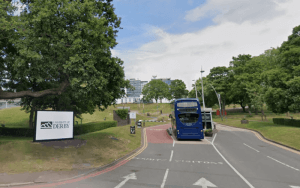A “hugely important” public inquiry into Network Rail’s plan to build an inaccessible footbridge will be a “line in the sand” for disabled activists who are determined to fight further such proposals.
They believe Network Rail plans to build other inaccessible footbridges across the country as a cost-saving measure, and in breach of its duties under the Equality Act.
They hope the government’s decision to hold a public inquiry into the proposed bridge at Copmanthorpe, near York, will persuade Network Rail to reconsider plans for other inaccessible bridges.
Accessible transport campaigners have a played a significant part in persuading the government to hold the inquiry into the Copmanthorpe proposals, which will see a stepped footbridge built as a replacement for a dangerous but accessible level crossing.
Network Rail had appealed against City of York Council’s decision to refuse permission to divert a footpath by closing the level crossing and building the footbridge.
Network Rail has argued that the crossing is not currently used by people with reduced mobility because of rough terrain on either side and that an accessible bridge would cost millions more pounds to build, while the ramps needed would be “visually intrusive”.
But local campaigners eventually hope to secure funding for an accessible “active travel” route between Copmanthorpe and the neighbouring village of Bishopthorpe along the course of the footpath.
Flick Williams, a powerchair-user from York, who first passed on concerns about the footbridge plans to other access campaigners, said she was “delighted” by the decision to hold a public inquiry.
She said: “If this is allowed to go ahead in its current form, it ends forever the possibility of an active travel route between the two villages.”
Williams said she fears that – if it is successful in the public inquiry – Network Rail will use that victory to argue for the right to build other inaccessible footbridges, and it will be “much, much harder for disabled people in other parts of the country to object because they will hold this up as a precedent”.
She told Disability News Service (DNS): “We are in the 21st century, we should be going forwards and not backwards, not building in inaccessibility for hundreds of years to come.
“It’s just discrimination against the many people who are not yet disabled.”
Fellow accessible transport campaigner Doug Paulley, who also lives near Copmanthorpe, has tested the footpath on either side of the crossing (pictured) and believes it could easily be made accessible for wheelchair-users, pushchair-users, cyclists, and others.
Paulley, also a wheelchair-user, told DNS that the Copmanthorpe case had become “a line in the sand”.
He said he and other activists were fighting hard to defeat Network Rail’s plans for Copmanthorpe because they hope to force it to think again on other plans for inaccessible footbridges.
He said: “We have this ageing infrastructure and it is very difficult to make it all accessible, but now they are building new inaccessible infrastructure where previously it was level.
“It just shows their attitude and their true contempt for disabled people. It would be locking in inaccessibility.”
The city council has said (PDF) the new footbridge would be expected to remain in place and “as is” for 120 years.
Paulley said the plans are particularly concerning because it is believed to be one of the first times – if not the first – that Network Rail is replacing an accessible crossing with one that is inaccessible.
He said: “I think it really is important. Even if they win [the public inquiry] they know they are potentially going to have to go through this process every time.”
He has already submitted written evidence outlining his concerns, and he hopes to give oral evidence to the inquiry.
Network Rail believes that adding ramps to the footbridge at a later stage could be achieved if funding was provided by another organisation, but that about 200 metres of extra land would be required.
Network Rail declined to say if it planned to build other inaccessible footbridges and if this was the first time it was replacing accessible infrastructure with an inaccessible bridge, suggesting that Disability News Service submit a freedom of information request as these were “detailed questions which will require a bit of digging”.
But a Network Rail spokesperson said: “We received confirmation yesterday (Monday 23 May) from the Transport Infrastructure Planning Unit that a public inquiry will take place later this year.
“We’ve done a great deal of work to look at who uses the level crossing and believe that we have designed a solution that meets their needs, makes the best use of taxpayers’ money and makes sense for this location with poor current accessibility, and this will be presented at the inquiry.”
A note from the editor:
Please consider making a voluntary financial contribution to support the work of DNS and allow it to continue producing independent, carefully-researched news stories that focus on the lives and rights of disabled people and their user-led organisations.
Please do not contribute if you cannot afford to do so, and please note that DNS is not a charity. It is run and owned by disabled journalist John Pring and has been from its launch in April 2009.
Thank you for anything you can do to support the work of DNS…

 Government’s ‘weak’ response to damning transport access report puts right to travel in ‘grave danger’
Government’s ‘weak’ response to damning transport access report puts right to travel in ‘grave danger’ Self-driving taxis that are not accessible will be allowed pilot scheme licenses, government suggests
Self-driving taxis that are not accessible will be allowed pilot scheme licenses, government suggests Disabled students set to protest over cuts in support
Disabled students set to protest over cuts in support